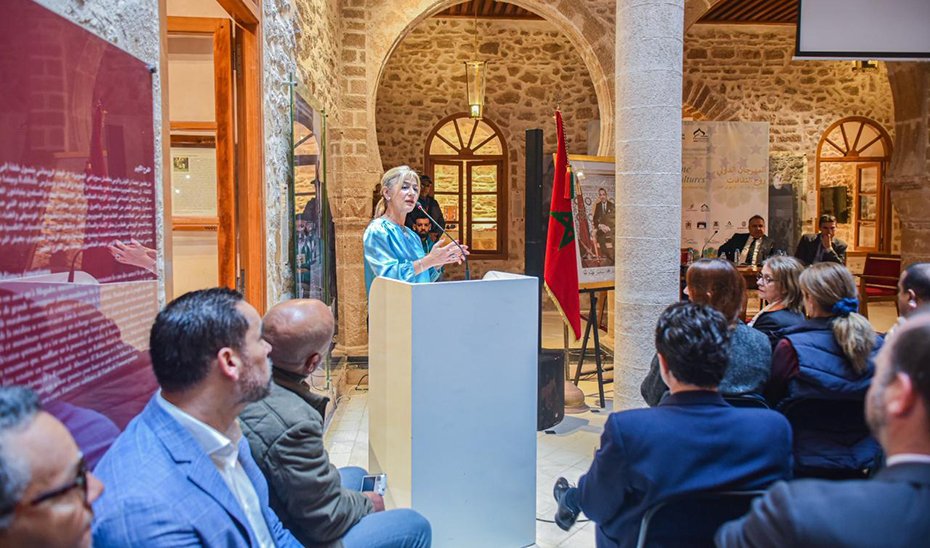The Minister of Culture and Sports, Patricia del Pozo, has inaugurated the third edition of the ‘El Alma de las Culturas’ Festival in the Moroccan city of Essaouira, organized by the Three Cultures of the Mediterranean Foundation and the Kadiriya Brotherhood of Essaouira (Association Jeunes de l’Art Authentique), in collaboration with the Machado Foundation and the support of the Embassy of Spain in Morocco.
In her speech, the Minister and co-president of the Three Cultures Foundation emphasized the power of culture to create spaces for encounter, dialogue, understanding, and peaceful coexistence, «something so necessary for future generations and for those for whom the present is confusing, extremely complex,» she emphasized.
According to Patricia del Pozo, these spaces allow us to build on what unites us and above what separates us, something that «we know very well in Andalusia because there we have been the result of mestizaje for centuries, carrying universal values that are never exclusive,» she explained.
Therefore, she highlighted the importance of this meeting that proposes «a journey to the depths of our traditions, with the best spiritual guides from Christian, Muslim, and Jewish communities, as well as numerous experts in craftsmanship and academics, in this celebration of diversity through dialogue and harmony.»
On the other hand, André Azoulay, advisor to the King of Morocco and co-president of the Three Cultures Foundation, highlighted the need for this festival and the message it sends to the world in favor of peaceful coexistence, encouraging all present to spread this powerful message beyond Essaouira to educate. «We are sure of what we have achieved, and the world needs to know,» he said in relation to the moments of unity and shared spiritualities among people of different backgrounds and religions experienced in the festival.
In the same vein, the Ambassador of Spain in Morocco, Enrique Ojeda, explained that «this festival reminds us that spiritual and artistic traditions can and should be an antidote to conflicts» and thanked very especially «the extraordinary role of the Junta de Andalucía, for all that Andalusia does and builds in the relationship between Spain and Morocco«.
Table dedicated to crafts
Right after, an interesting panel of experts dedicated to crafts as a living legacy and a vehicle for the transmission of knowledge began, with the participation of experts in the field of crafts and heritage of Andalusia and Essaouira, moderated by Moha Er Rich, Director of Heritage Conservation, Innovation, and Promotion at the Ministry of Crafts of Morocco.
The first to speak was the Sevillian José de Léon, an expert in sumptuous arts, curator, disseminator, and creator of the podcasts ‘Sacra Conversazione’ and ‘This Is Macarena’, who showed the similarities and common roots between different craft traditions.
In this sense, he pointed out that «the Holy Week of Seville, and in general that of Andalusia, is different from the rest of Spain due to the refinement and sumptuousness of its steps and belongings. This authenticity is due to the Andalusian legacy that still marks the idiosyncrasy of the people, who satisfy their aesthetic sense with sophisticated, complex, and luxurious works,» as «just like in Muslim buildings, decoration for Holy Week is not an accessory, it is the essence that culminates the work, providing it with vision, identity, and meaning.»
Regarding the craft brotherhoods, he noted that they constitute «a transversal heritage because they connect us with all the culture of the Mediterranean, which the Islam brought with it and introduced to the peninsula for more than five centuries. Many of the works treasured by the brotherhoods owe their philosophical foundation, morphological motifs, and composition to sumptuous arts cultivated by the Umayyads, consolidated in the taifas, and remained in vogue until the Almohads. We also owe them their technique, such as gold embroidery or silversmithing.»
Francisco Carrera ‘Paquili’, president of the Sevillian Guild Association of Sacred Art, argued that «craftsmanship is a hallmark of identity and a fundamental culture to know a country.» In this sense, he maintained that «artists and artisans transmit a centuries-old legacy, creating art, wealth, culture, identity, and heritage,» to which he added, «Seville is an artistic reference because it has known how to maintain these traditions and project them towards new horizons. Seville is the capital of the world of sacred art.»
On the Moroccan side, Youssef Jeddi, designer and creator in Moroccan artistic craftsmanship, specializing in thuja wood and president of the board of directors of the union of marquetry cooperatives in thuja wood in Essaouira; Abdelhafid Essabi, master jeweler craftsman and president of the union of cooperatives of the integrated craft complex ARGANA; and Abdeljalil Bassis: master jeweler craftsman and bearer of the torch of the ‘Treasures of Moroccan traditional arts’ participated.
Subsequently, the participants were able to see firsthand the work of the artisans of Essaouira in a visit to several of their workshops, while yesterday the Panda de Verdiales Santo Pitar de Málaga toured the streets of the Moroccan city on Friday afternoon, joining the groups representing the different zaouias in an atmosphere of spirituality and shared celebration.

